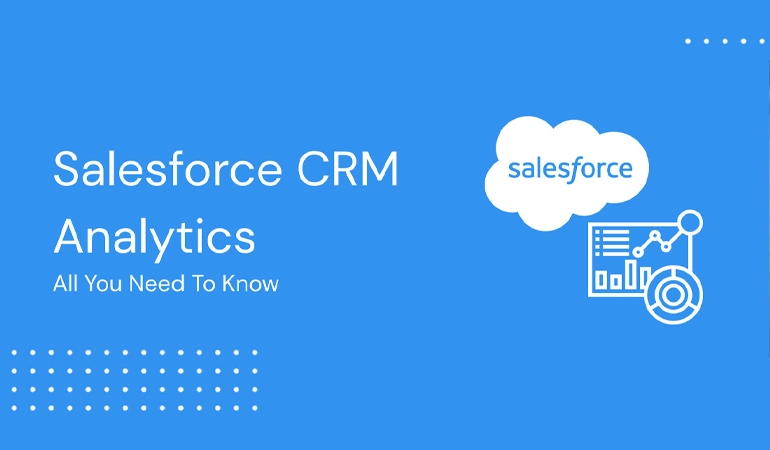Salesforce CRM Analytics | Your Complete Guide

Modern enterprise success is closely tied to a company’s ability to harness the power of data. Data is the key to all growth and success. However, raw, unrefined data alone is of little to no use, which is why data analytics and business intelligence (BI) tools and platforms have gained so much popularity in recent years. Salesforce CRM, the world’s leading customer relationship management platform, offers an in-built analytics tool called CRM Analytics.
This article explores Salesforce CRM Analytics in detail, providing a comprehensive overview of why you need to use it and how to implement it.
What is Salesforce CRM Analytics?
CRM Analytics (also called Tableau CRM), formerly known as Einstein Analytics, is a robust data analytics and business intelligence (BI) tool embedded in the Salesforce CRM platform. It allows users to aggregate and analyze data from various sources within their Salesforce CRM ecosystem to derive actionable insights and enable data-driven decision-making.
Salesforce CRM Analytics leverages technologies like AI (artificial intelligence), ML (machine learning), and predictive analytics to provide users with critical business insights regarding customer behavior and sales efficiency. It lets users:
- Create personalized dashboards with drag-and-drop functionality to visualize key performance indicators (KPIs), metrics, and trends. Dashboards provide a comprehensive view of business performance at a glance.
- Identify trends in customer behavior and preferences based on customer engagement.
- Generate detailed reports based on specific criteria and filters. Users can also customize reports to suit individual needs and preferences.
- Integrate CRM Analytics with various data sources, including Salesforce CRM data, external databases, spreadsheets, and cloud applications, to provide a unified view of business data.
- Use predictive analytics to forecast future outcomes.
- Collaborate on reports, share insights, and drive alignment towards common goals.
Take the example of a retail business operating both digitally and physically. Such a business will have data coming in from diverse sources. CRM Analytics streamlines data management and analytics by centralizing data from these sources into a single platform.
As a result, the business can easily analyze how its different physical and online stores are performing, what customers require, and how it can optimize its inventory management.
However, Tableau CRM is not just for retail businesses – any company already using Salesforce Sales Cloud can leverage this built-in analytics tool to gather important sales and customer-related insights.
Five Reasons to Utilize Salesforce CRM Analytics
Research shows that many companies fail to utilize their data properly, leading to inefficiencies and lost growth opportunities. The reason is that these businesses lack a comprehensive data analytics strategy. Companies using Salesforce have many reasons to leverage CRM Analytics, the most important of which is the fact that it lets you make the most of your Salesforce CRM platform.
Here are five reasons why a Salesforce user should use CRM Analytics:
1. Data Optimization:
CRM Analytics allows you to maximize your data value by letting you analyze it comprehensively. This allows you to uncover insights, trends, and patterns that may otherwise go unnoticed, leading to more informed decision-making and improved operational efficiency.
2. Competitive Advantage:
Achieving and maintaining competitive advantage is one of the cornerstones of business success. CRM Analytics gives you a sure-shot competitive edge over rivals who are not effectively utilizing their data. Access to real-time insights enables you to adapt quickly to market changes, identify opportunities, and stay ahead of your competition.
3. Strategic Decision-Making:
CRM Analytics provides valuable insights into customer behavior, preferences, and trends, empowering you to make strategic decisions that are aligned with customer needs and market demands. Such insights allow you to craft and execute targeted marketing campaigns, provide personalized customer experiences, and increase your customer satisfaction and loyalty.
4. Process Optimization:
Analytical CRM data can highlight inefficiencies and bottlenecks in sales, marketing, and customer service processes. You or your CRM analyst can easily identify areas that need improvement and follow it up by streamlining operations. This process optimization strategy will enhance productivity and deliver better outcomes for both customers and the business.
5. Revenue Growth:
Effective use of CRM Analytics can lead to improved sales performance and revenue growth. You can identify high-value leads, make sense of customer buying patterns, and anticipate customer needs and market changes with Tableau CRM. Your sales team can prioritize its efforts and close deals more effectively, resulting in increased revenue and profitability.
Who Can Use CRM Analytics?
CRM Analytics can be utilized by various roles within an organization, each with their specific functions and responsibilities. Here are some example roles:
1. Sales Representatives/Managers:
Sales teams can use CRM Analytics to track their performance, analyze sales trends, and identify opportunities for upselling or cross-selling. They can also gain insights into customer preferences and behaviors to tailor their sales strategies accordingly.
2. Marketing Professionals:
Marketing teams can also leverage Tableau CRM to measure the effectiveness of their campaigns, track customer engagement, and identify the most profitable marketing channels. They can also segment customers based on demographics or behaviors to create targeted marketing campaigns.
3. Customer Service Representatives/Managers:
Customer service teams can make use of Tableau CRM to track customer satisfaction scores, analyze support ticket data, and identify recurring issues or trends. They can also anticipate customer needs and proactively address potential issues before they escalate.
4. Data Analysts/Scientists:
Data analysts and scientists play a crucial role in extracting insights from CRM data using advanced analytics techniques such as data mining, predictive modeling, and machine learning. They can identify correlations, patterns, and trends in the data that may not be immediately apparent.
5. Executives/Decision Makers:
Executives and decision-makers rely on analytical CRM data to make strategic decisions based on data-driven insights. They use dashboards and reports generated by CRM Analytics to monitor key performance indicators (KPIs), track progress toward business goals, and allocate resources effectively.
6. IT Administrators:
IT administrators are responsible for managing the technical aspects of Salesforce CRM Analytics, including data integration, system maintenance, and security. They ensure that Tableau CRM tools are properly configured and optimized to meet the organization’s needs.
How to Implement Salesforce CRM Analytics
Here’s a step-by-step guide to implementing CRM Analytics:
1. Create a Dashboard
You can start utilizing CRM Analytics after creating a dashboard using a template. These templates offer a pre-built design with customizable widgets and queries.
2. Utilize Reusable Components to Create & Manage Dashboards
You can either create your own components or work with the ones provided by Salesforce. Dashboard components save you time when you create dashboards. These reusable components include lightning web components, widgets, and pages that help you implement CRM Analytics with ease.
3. Change Data into Widgets
You can use repeater widgets to manage tabular or spreadsheet data. They let you show multiple rows of data in a single widget. You can also utilize Input Widgets to filter your data, retrieve information, and determine how the dashboards look in real-time.
4. Create Dashboard Pages
In this step, you can turn your attention to creating dashboard pages. One benefit is that you can easily break down large dashboards into smaller ones, allowing you to manage various sections of the dashboard much more easily.
5. Add, Copy/Paste Widgets
Widgets are the mainstay of a CRM Analytics dashboard, capable of executing several tasks like showing record-level information, filtering and visualizing data, and calculating key performance indicators (KPIs). You can even copy and paste widgets between dashboards, thus helping you save time. It also helps you maintain consistency across the organization’s dashboards.
6. Handle Widget Queries
You can develop queries on several data sources, including Salesforce objects and datasets to display them atop the widgets. Not only that but you can also create dynamic and interactive dashboards using custom queries.
7. Make Widgets Interactive
Add interactions like appearance updates, sorting data, or additional information to the dashboard widgets to make them more interesting and interactive.
8. Determine Initial Selections & Global Filters
You can manage your dashboard data by implementing global filters and selections. This enables users to change the data being displayed without editing the dashboard.
9. Optimize for Performance
You need to make sure that dashboard optimization is prioritized during the implementation process. This can be achieved by utilizing caching and running the dashboard inspector, which limits the number of queries per page.
10. Leverage Keyboard Shortcuts
Go through Salesforce’s CRM Analytics help guide to create keyboard shortcuts for your analytics dashboard and lenses.
Tableau vs. Tableau CRM
Tableau is a standalone business intelligence platform that can connect to various kinds of data sources beyond the Salesforce ecosystem. It is one of the hottest BI and data visualization tools out there, offering users the capability to perform complex data manipulations, explore data in depth, and develop highly customized data visualizations and dashboards. As such, it is typically the top choice for organizations dealing with a wide variety of data sources.
Tableau CRM, now known as CRM Analytics, is designed specifically for managing and harnessing the data in the Salesforce ecosystem. It provides users with pre-built dashboard templates and reports that are aligned to provide real-time insights to sales and customer management teams. Its typical target audience includes Salesforce users who wish to make the most of their Salesforce data.
Conclusion
As Salesforce continues to be the most dominant CRM in the world, one can expect a significant increase in CRM Analytics users. It is an essential analytics tool for Salesforce users looking to derive actionable insights from their Salesforce data.
However, Salesforce implementation, including CRM Analytics implementation, requires technical expertise due to its complexity. A faulty or inadequate implementation with no regard for strategic goals and core competencies can cost you dearly. This is where Salesforce development services and CRM analysts come into play.
Xavor is a registered Salesforce Consulting Partner. Our certified Salesforce developers deliver tailored Salesforce solutions that meet your business needs effectively. Drop us a line today to discuss your Salesforce CRM Analytics implementation with our Salesforce team.



